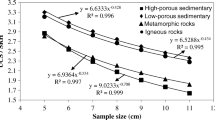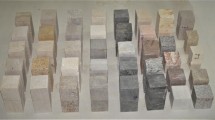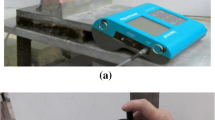Abstract
The main purpose of this research is to determine the dry and saturated strength of different sedimentary rocks including travertine, conglomerate, sandstone and limestone by using the Schmidt hammer test. To determine the strength of the studied rocks, comprehensive geotechnical tests including Brazilian tensile strength (BTS), block punch strength (BPS), point load strength (PLS) and uniaxial compressive strength (UCS) were performed in dry and saturated conditions on prepared standard specimens. Results show under BTS, BPS, PLS and UCS tests, the strength of the studied rocks after saturating is averagely reduced by 24.95, 31.80, 34.36 and 18.97%, respectively. Therefore, under saturated conditions, the strength of the studied samples reduced 27.52% averagely. The correlation between Schmidt rebound hardness and geotechnical properties in dry and saturated conditions was performed by simple regression analysis and experimental equations were obtained with a correlation coefficient from 0.65 to 0.93. For evaluating the performance of predictive models, some statistical parameters including RMSE, VAF, MAPE and PI were calculated and the 45° line and 95% confidence limit curves were also extracted for evaluating the validity of the concluded empirical equations. The results of this research demonstrate that the Schmidt hammer test is a reliable method for estimating the strength of rocks in dry and saturated conditions.






Similar content being viewed by others
References
Ajalloeian R, Jamshidi A, Khorasani R (2020) Evaluating the effects of mineral grain size and mineralogical composition on the correlated equations between strength and Schmidt hardness of granitic rocks. Geotech Geol Eng. https://doi.org/10.1007/s10706-020-01321-6
Aladejare AE (2020) Evaluation of empirical estimation of uniaxial compressive strength of rock using measurements from index and physical tests. J Rock Mech Geotech Eng 12(2):256–268
Armaghani DJ, Safari V, Fahimifar A, Amin MFM, Monjezi M, Mohammadi MA (2018) Uniaxial compressive strength prediction through a new technique based on gene expression programming. Neural Comput Appl 30:3523–3532
Asheghi R, Shahri AA, Zak MK (2019) Prediction of uniaxial compressive strength of different quarried rocks using metaheuristic algorithm. Arab J Sci Eng 44:8645–8659
Asteris PG, Mamou A, Hajihassani M, Hasanipanah M, Koopialipoor M, Le T, Kardani N, Armaghani DJ (2021) Soft computing based closed form equations correlating L and N-type Schmidt hammer rebound numbers of rocks. Trans Geotech. https://doi.org/10.1016/j.trgeo.2021.100588
ASTM International (1995) Standard test method for unconfined compressive strength of intact rock core specimens. ASTM standards on disc 04.08; Designation: D2938
Aufmuth RE (1973) A systematic determination of engineering criteria for rocks. Bull Assoc Eng Geol 11:235–245
Aydin A, Basu A (2005) The Schmidt hammer in rock material characterization. Eng Geol 81(1):1–14
Basu A, Aydin A (2004) A method for normalization of Schmidt hammer rebound values. Int J Rock Mech Min Sci 41(7):1211–1214
Bilen C (2021) Schmidt hammer rebound (SHR) values as a guide for the initial estimate of limestone uniaxial compressive strength (UCS) and Hardgrove grindability index (HGI). Arab J Geosci 14. https://doi.org/10.1007/s12517-021-08421-4
Bruno G, Vessia G, Bobbo L (2013) Statistical method for assessing the uniaxial compressive strength of carbonate rock by Schmidt hammer tests performed on core samples. Rock Mech Rock Eng 46:199–206
Buyuksagis IS, Goktan RM (2007) The effect of Schmidt hammer type on uniaxial compressive strength prediction of rock. Int J Rock Mech Min Sci 44:299–307
Demirdag S, Sengun N, Ugur I, Altindag R (2018) Estimating the uniaxial compressive strength of rocks with Schmidt rebound hardness by considering the sample size. Arab J Geosci. https://doi.org/10.1007/s12517-018-3847-1
Demirdag S, Yavuz H, Altindag R (2009) The effect of sample size on Schmidt rebound hardness value of rocks. Int J Rock Mech Min Sci 46:725–730
Diamantis K (2019) Estimation of tensile strength of ultramafic rocks using indirect approaches. Geomech Eng 17(3):261–270
Diamantis K, Fereidooni D, Khajevand R, Migiros G (2021) Effect of textural characteristics on engineering properties of some sedimentary rocks. J Cent South Univ 28:926–938
Diamantis K, Gartzos E, Migiros G (2014) Influence of petrographic characteristics on physico-mechanical properties of ultrabasic rocks from central Greece. Bull Eng Geol Environ 73:1273–1292
Duda M, Renner J (2013) The weakening effect of water on the brittle failure strength of sandstone. Geophys J Int 192(3):1091–1108
Erguler ZA, Ulusay R (2009) Water-induced variations in mechanical properties of clay-bearing rocks. Int J Rock Mech Min Sci 46:355–370
Fattahi H (2017) Applying soft computing methods to predict the uniaxial compressive strength of rocks from Schmidt hammer rebound values. Comput Geosci 21:665–681
Fereidooni D (2016) Determination of the geotechnical characteristics of Hornfelsic rocks with a particular emphasis on the correlation between physical and mechanical properties. Rock Mech Rock Eng 49:2595–2608
Fereidooni D, Khajevand R (2018) Determining the geotechnical characteristics of some sedimentary rocks from Iran with an emphasis on the correlations between physical, index, and mechanical properties. Geotech Test J 41(3):555–573
Fereidooni D, Khajevand R (2019) Utilization of the accelerated weathering test method for evaluating the durability of sedimentary rocks. Bull Eng Geol Environ 78:2697–2716
Hebib R, Belhai D, Alloul B (2017) Estimation of uniaxial compressive strength of North Algeria sedimentary rocks using density, porosity, and Schmidt hardness. Arab J Geosci. https://doi.org/10.1007/s12517-017-3144-4
Heidari M, Mohseni H, Jalali SH (2018) Prediction of uniaxial compressive strength of some sedimentary rocks by fuzzy and regression models. Geotech Geol Eng 36:401–412
Huang S, Xia K, Yan F, Feng XT (2010) An experimental study of the rate dependence of tensile strength softening of Longyou sandstone. Rock Mech Rock Eng 43(6):677–683
ISRM (1979) Suggested methods for determining the uniaxial compressive strength and deformability of rock materials. Int J Rock Mech Min Sci Geomech Abstr 16(2):135–140
ISRM (2007) The Blue Book: the complete ISRM suggested methods for rock characterization, testing and monitoring, 1974–2006, Compilation Arranged by the ISRM Turkish National Group, Ankara, Turkey, R Ulusay and JA Hudson, Eds., Kazan Offset Press, Ankara
Jing H, Nikafshan Rad H, Hasanipanah M, Armaghani DJ, Noman Qasem S (2021) Design and implementation of a new tuned hybrid intelligent model to predict the uniaxial compressive strength of the rock using SFS-ANFIS. Eng Comput 37:2717–2734
Karakul H (2017) Investigation of saturation effect on the relationship between compressive strength and Schmidt hammer rebound. Bull Eng Geol Environ 76:1143–1152
Karakul H (2020) Investigation of the effect of impact direction on Schmidt rebound values by multivariate regression and neuro-fuzzy model. SN Appl Sci. https://doi.org/10.1007/s42452-020-03600-6
Karakul H, Ulusay R (2013) Empirical correlations for predicting strength properties of rocks from P-wave velocity under different degrees of saturation. Rock Mech Rock Eng 46(5):981–999
Karaman K, Kesimal A (2015) Correlation of Schmidt rebound hardness with uniaxial compressive strength and P-wave velocity of rock materials. Arab J Sci Eng 40:1897–1906
Karaman K, Kesimal A, Ersoy H (2015) A comparative assessment of indirect methods for estimating the uniaxial compressive and tensile strength of rocks. Arab J Geosci 8:2393–2403
Khajevand R, Fereidooni D (2019) Utilization of the point load and block punch strengths to predict the mechanical properties of several rock samples using regression analysis methods. Innov Infrastruct Solut. https://doi.org/10.1007/s41062-019-0201-8
Kogure T (2019) Analysis of Schmidt hammer rebound test results with repetitive impacts for determining the mechanical characteristics of weathered pyroclastic rock surfaces: a case study along the Isotake coast, Japan. Bull Eng Geol Environ 78:3425–3432
Kong F, Shang J (2018) A validation study for the estimation of uniaxial compressive strength based on index tests. Rock Mech Rock Eng 51:2289–2297
Kong F, Xue Y, Qiu D, Gong H, Ning Z (2021) Effect of grain size or anisotropy on the correlation between uniaxial compressive strength and Schmidt hammer test for building stones. Constr Build Mater. https://doi.org/10.1016/j.conbuildmat.2021.123941
Li D, Wang W (2019) Quantitative analysis of the influence of saturation on rock strength reduction considering the distribution of water. Geomech Geophys Geo-Energy Geo-Resour 5:197–207
Li D, Wong LNY, Liu G, Zhang XP (2012) Influence of water content and anisotropy on the strength and deformability of low porosity meta-sedimentary rocks under triaxial compression. Eng Geol 126:46–66
Liang M, Mohamad ET, Faradonbeh RS, Armaghani DJ, Ghoraba S (2016) Rock strength assessment based on regression tree technique. Eng Comput 32:343–354
Liu Y, Cai Y, Huang S, Guo Y, Liu G (2020) Effect of water saturation on uniaxial compressive strength and damage degree of clay-bearing sandstone under freeze-thaw. Bull Eng Geol Environ 79:2021–2036
Luo Y (2020) Influence of water on mechanical behavior of surrounding rock in hard-rock tunnels: an experimental simulation. Eng Geol. https://doi.org/10.1016/j.enggeo.2020.105816
Ma L, Wu J, Wang M, Dong L, Wei H (2020) Dynamic compressive properties of dry and saturated coral rocks at high strain rates. Eng Geol. https://doi.org/10.1016/j.enggeo.2020.105615
Microsoft Corporation (2018) Microsoft Excel. Retrieved from https://office.microsoft.com/excel
Mishra DA, Srigyan M, Basu A, Rokade PJ (2015) Soft computing methods for estimating the uniaxial compressive strength of intact rock from index tests. Int J Rock Mech Min Sci 80:418–424
Mishra S, Khetwal A, Chakraborty T (2019) Physio-mechanical characterization of rocks. J Test Eval 49(3):1976–1998
Moosavi SA, Mohammadi M (2021) Development of a new empirical model and adaptive neuro-fuzzy inference systems in predicting unconfined compressive strength of weathered granite grade III. Bull Eng Geol Environ 80:2399–2413
Rahimi MR, Mohammadi SD, Beydokhti AT (2022) Correlation between Schmidt hammer hardness, strength properties and mineral compositions of sulfate rocks. Geotech Geol Eng 40:545–574
Rajabzadeh MA, Moosavinasab Z, Rakhshandehroo G (2012) Effects of rock classes and porosity on the relation between uniaxial compressive strength and some rock properties for carbonate rocks. Rock Mech Rock Eng 45(1):113–122
Sharma PK, Khandelwal M, Singh TN (2011) A correlation between Schmidt hammer rebound numbers with impact strength index, slake durability index and P-wave velocity. Int J Earth Sci 100:189–195
Sonmez H, Gokceoglu C, Nefeslioglu HA, Kayabasi A (2006) Estimation of rock modulus: for intact rocks with an artificial neural network and for rock masses with a new empirical equation. Int J Rock Mech Min Sci 43(2):224–235
Sumner P, Werner N (2002) The effect of rock moisture on Schmidt hammer rebound: tests on rock samples from Marion Island and South Africa. Earth Surf Proc Land 27(10):1137–1142
Tandon RS, Gupta V (2015) Estimation of strength characteristics of different Himalayan rocks from Schmidt hammer rebound, point load index, and compressional wave velocity. Bull Eng Geol Environ 74:521–533
Tang S (2018) The effects of water on the strength of black sandstone in a brittle regime. Eng Geol 239:167–178
Tang Z, Li S, Huang S, Huang F, Wan F (2021) Indirect estimation of rock uniaxial compressive strength from simple index tests: review and improved least squares regression tree predictive model. Geotech Geol Eng 39:3843–3862
Török A, Vásárhelyi B (2010) The influence of fabric and water content on selected rock mechanical parameters of travertine, examples from Hungary. Eng Geol 115:237–245
Tuğrul A, Zarif IH (1999) Correlation of mineralogical and textural, characteristics with engineering properties of selected granitic rocks from Turkey. Eng Geol 51(4):303–317
Vásárhelyi B (2005) Statistical analysis of the influence of water content on the strength of the Miocene limestone. Rock Mech Rock Eng 38(1):69–76
Wang M, Wan W (2019) A new empirical formula for evaluating uniaxial compressive strength using the Schmidt hammer test. Int J Rock Mech Min Sci. https://doi.org/10.1016/j.ijrmms.2019.104094
Wasantha PLP, Ranjith PG, Permata G, Bing D (2018) Damage evolution and deformation behaviour of dry and saturated sandstones: insights gleaned from optical measurements. Measurement 130:8–17
Wen L, Luo ZQ, Yang SJ, Qin YG, Wang W (2019) Correlation of geo-mechanics parameters with uniaxial compressive strength and P-wave velocity on dolomitic limestone using a statistical method. Geotech Geol Eng 37:1079–1094
Wong LNY, Maruvanchery V, Liu G (2016) Water effects on rock strength and stiffness degradation. Acta Geotech 11(4):713–737
Yao W, Li C, Zhan H, Zhou JQ, Criss RE, Xiong S, Jiang X (2020) Multiscale study of physical and mechanical properties of sandstone in three Gorges reservoir region subjected to cyclic wetting–drying of Yangtze River Water. Rock Mech Rock Eng 53:2215–2231
Yilmaz I (2010) Influence of water content on the strength and deformability of gypsum. Int J Rock Mech Min Sci 47(2):342–347
Yılmaz I, Sendir H (2002) Correlation of Schmidt hardness with unconfined compressive strength and Young’s modulus in gypsum from Sivas (Turkey). Eng Geol 66:211–219
Yu CY, Tang SB, Tang CA, Duan D, Zhang YJ, Liang ZZ, Ma K, Ma TH (2019) The effect of water on the creep behavior of red sandstone. Eng Geol 253:64–74
Zhao K, Yang D, Zeng P, Huang Z, Wu W, Li B, Teng T (2021) Effect of water content on the failure pattern and acoustic emission characteristics of red sandstone. Int J Rock Mech Min Sci 142:104709. https://doi.org/10.1016/j.ijrmms.2021.104709
Zhou Z, Cai X, Cao W, Li X, Xiong C (2016) Influence of water content on mechanical properties of rock in both saturation and drying processes. Rock Mech Rock Eng 49:3009–3025
Acknowledgements
The author like to express his thanks to Mr. P. Khajevand for the English editing.
Funding
No external funding was used.
Author information
Authors and Affiliations
Corresponding author
Ethics declarations
Conflict of interest
The author does not have any conflict of interest.
Ethical Approval
This article does not contain any studies with human participants.
Rights and permissions
Springer Nature or its licensor (e.g. a society or other partner) holds exclusive rights to this article under a publishing agreement with the author(s) or other rightsholder(s); author self-archiving of the accepted manuscript version of this article is solely governed by the terms of such publishing agreement and applicable law.
About this article
Cite this article
Khajevand, R. Determining Dry and Saturated Strength of Rocks by Using the Schmidt Hammer. Iran J Sci 47, 779–790 (2023). https://doi.org/10.1007/s40995-023-01436-4
Received:
Accepted:
Published:
Issue Date:
DOI: https://doi.org/10.1007/s40995-023-01436-4




